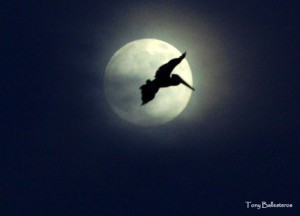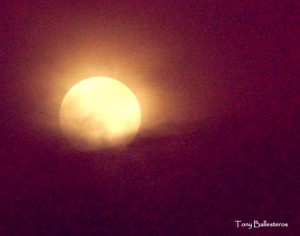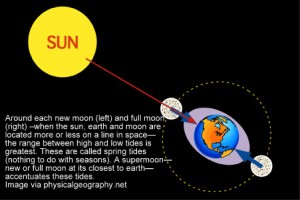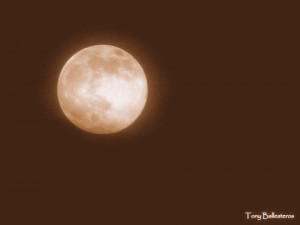Now that we’re two supermoons into the three in a row scheduled for this year, the third scheduled to happen on September 9th, it’s appropriate to talk about the effect our moon has on tides around the planet and how that works.
 What’s interesting is that there are still conflicting beliefs about whether the moon actually affects our tides, especially when you consider that, in order to deny the effect, one has to deny the existence of laws of gravity, gravitational pull and other major scientific evidence explaining everything from planet rotation to orbital patterns that have been recorded for centuries as well as many other proven scientific theories.
What’s interesting is that there are still conflicting beliefs about whether the moon actually affects our tides, especially when you consider that, in order to deny the effect, one has to deny the existence of laws of gravity, gravitational pull and other major scientific evidence explaining everything from planet rotation to orbital patterns that have been recorded for centuries as well as many other proven scientific theories.
This article, however, is not about conflicting theories. For this article we’re accepting the law of gravitation as originally formulated by Isaac Newton back in 1666, who, 20 years later, was also the first person to scientifically explain tides.
First we need to understand that there is a gravitational attraction between all objects and the force of that attraction depends on the mass and distance between the objects. From the smallest rocks, which have no discernible gravitational force between each other—even though each separately is definitely and noticeably affected by the earth’s gravitational pull, as the “apple falling from the tree” axiom—due to their size, to the mind boggling mass and distance of the earth, moon and sun.
The term “tides” is a generic term used to define the rise and fall in sea levels produced by the gravitational attraction of the moon and the sun. In fact, although to a much smaller extent, tides, or gravitational attractions also occur in large lakes, the atmosphere, and even within the solid crust of the earth. Like a magnet, the moon tries to pull at anything on the earth but our planet pulls back with equal force (from Newton’s Laws of Motion: For every action there is an equal and opposite reaction) and is able to hold onto everything except our large bodies of water, which are in constant motion. This lunar force causes the oceans to bulge out toward the moon. Since the earth is also being side as the earth is pulled away from the water on that far side.
and the sun. In fact, although to a much smaller extent, tides, or gravitational attractions also occur in large lakes, the atmosphere, and even within the solid crust of the earth. Like a magnet, the moon tries to pull at anything on the earth but our planet pulls back with equal force (from Newton’s Laws of Motion: For every action there is an equal and opposite reaction) and is able to hold onto everything except our large bodies of water, which are in constant motion. This lunar force causes the oceans to bulge out toward the moon. Since the earth is also being side as the earth is pulled away from the water on that far side.
Because the earth is rotating during all this, two tides occur each day, two high tides about12 hours and 25 minutes apart and two low tides in between. This is why when you check your tide chart to determine the best times to walk the beach, you’ll notice that the low (or high) tide will be about 50 minutes later tomorrow than today, and about 25 minutes later this afternoon than this morning.
 As the moon makes its elliptical orbit around the earth (once every 27.3 days) while the earth makes its elliptical orbit around the sun (once every 365 days), there are periods when the moon is aligned between the earth and the sun, or when the earth is aligned between the sun and the moon. When the moon is between the earth and the sun in alignment, it is called the new moon. When the alignment of the earth is between the sun and the moon, it is called the full moon.
As the moon makes its elliptical orbit around the earth (once every 27.3 days) while the earth makes its elliptical orbit around the sun (once every 365 days), there are periods when the moon is aligned between the earth and the sun, or when the earth is aligned between the sun and the moon. When the moon is between the earth and the sun in alignment, it is called the new moon. When the alignment of the earth is between the sun and the moon, it is called the full moon.
Since each of these alignments involve gravitational interaction between the sun, moon and earth, the tidal force is much greater than when the three bodies are not in alignment. Hence, the radical difference in the high and low tides along the beaches that cause our walks to be so interesting as far as discovering fascinating marine life and shells left uncovered or on display in the shallow tide pools.
Tidal forces become even more contrasted every one year, one month and 18 days. This is when a full moon takes place in concurrence with it closest orbital point (called perigee, proxigee or supermoon) with the earth. For more on supermoons, check last month’s blog at https://www.sonoranresorts.mx/?p=12698.
To be a supermoon, a full or new moon doesn’t have to be at its closest orbital point to earth; it only has to be within 90% of its  nearest point. That’s why we can have 4-6 supermoons in a year, like this year. We had two super new moons in January and three in a row in July 12th, August 10th, with the third coming on September 9th. The supermoon of August 10th was the closest perigee alignment of the three. But don’t let that keep you inside on the nights of September 9th and 10th , even 11th, especially if the skies are clear because a supermoon is still way brighter than a normal full moon and will look full for several nights.
nearest point. That’s why we can have 4-6 supermoons in a year, like this year. We had two super new moons in January and three in a row in July 12th, August 10th, with the third coming on September 9th. The supermoon of August 10th was the closest perigee alignment of the three. But don’t let that keep you inside on the nights of September 9th and 10th , even 11th, especially if the skies are clear because a supermoon is still way brighter than a normal full moon and will look full for several nights.
We thank Earthsky.org, NASA, Windows to the Universe.org, EnchantedLearning.com for their information and graphics, and Tony Ballesteros for his photos of the August 10th supermoon.
This blog is powered by www.sonoranresorts.mx, Jim Ringquist, Director of Sales and Marketing.

